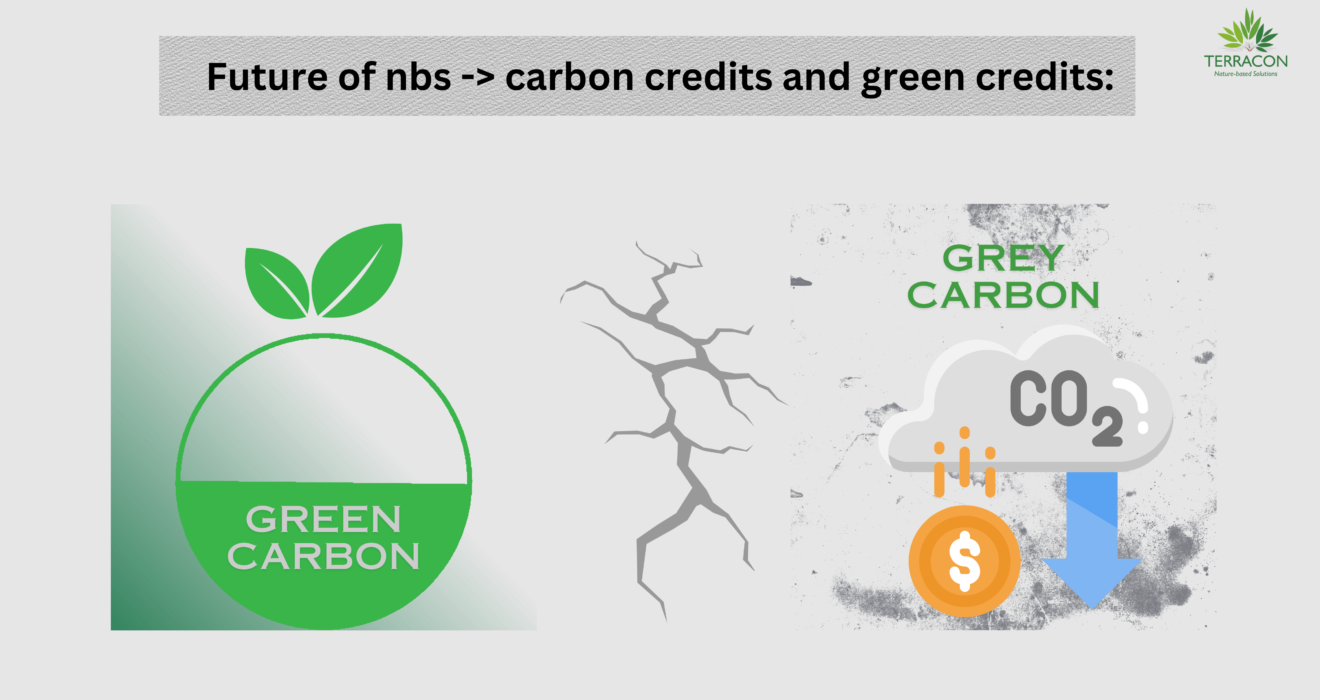Introduction:
In a world where the impacts of climate change are becoming increasingly evident, Nature-based Solutions (NbS) offer a beacon of hope for a more sustainable future. As we look ahead, the integration of carbon credits and green credits into the NbS framework holds immense potential to accelerate the transition towards a low-carbon, resilient society. Join us on a journey to explore the future of NbS and the transformative role of carbon credits and green credits in shaping our path forward.
Learn more about what is Nature-based Solutions (NbS) click here
Understanding NbS:
Before we delve into the future of NbS, let’s first understand what NbS entails. Nature-Based Solutions encompass a diverse range of strategies and practices that harness the power of nature to address environmental challenges and promote sustainable development. From reforestation and wetland restoration to green infrastructure and sustainable agriculture, NbS offer innovative and cost-effective approaches to mitigating climate change, conserving biodiversity, and enhancing ecosystem services.
The Promise of Carbon Credits:

Carbon credits, also known as carbon offsets, are a market-based mechanism designed to incentivize greenhouse gas emissions reductions and promote climate mitigation efforts. By quantifying and monetizing the carbon sequestration and storage potential of NbS projects, carbon credits provide a financial incentive for investment in NbS initiatives. This not only helps to offset emissions from other sources but also generates revenue for NbS project developers, making them more economically viable and attractive.
Carbon credits can be generated through various NbS activities, such as afforestation and reforestation projects, soil carbon sequestration initiatives, and avoided deforestation efforts. By quantifying the carbon benefits of these projects and issuing carbon credits accordingly, governments, businesses, and individuals can support NbS implementation and contribute to global climate action goals.
The Emergence of Green Credits:

In addition to carbon credits, the concept of green credits is gaining traction as a means to incentivize broader environmental and social benefits associated with NbS projects. Green credits go beyond carbon mitigation to recognize and reward the multiple ecosystem services provided by NbS, such as biodiversity conservation, water purification, and flood protection.
Unlike carbon credits, which focus primarily on carbon sequestration and emissions reductions, green credits take a holistic approach to environmental stewardship, accounting for the full range of ecosystem services delivered by NbS projects. This provides greater flexibility and scalability in valuing and monetizing the broader benefits of NbS, thereby enhancing their economic viability and sustainability.
The Role of Policy and Regulation:

As the demand for carbon credits and green credits continues to grow, the role of policy and regulation becomes increasingly important in shaping the future landscape of NbS finance. Governments play a critical role in creating the regulatory frameworks and market mechanisms necessary to support the development and trading of carbon credits and green credits.
Policy instruments such as carbon pricing mechanisms, emissions trading schemes, and voluntary offset programs provide the foundation for carbon credit markets, incentivizing emissions reductions and promoting investment in NbS projects. Similarly, regulations and incentives aimed at promoting green finance and sustainable investment can help to catalyze the market for green credits, encouraging private sector engagement and innovation in NbS financing.
The Benefits of NbS Financing:

The integration of carbon credits and green credits into the NbS framework offers a range of benefits for both the environment and society. By providing a financial incentive for investment in NbS projects, carbon credits and green credits help to scale up NbS implementation and accelerate progress towards climate and sustainability goals.
From a financial perspective, NbS financing offers attractive returns on investment, with the potential to generate revenue through the sale of carbon credits and green credits. This not only incentivizes private sector engagement in NbS projects but also leverages additional funding from public and philanthropic sources, creating a virtuous cycle of investment in nature-based solutions.
Furthermore, NbS financing contributes to a range of co-benefits beyond carbon mitigation, including improved air and water quality, enhanced biodiversity, and increased resilience to climate change and natural disasters. By valuing and monetizing these co-benefits through green credits, NbS financing provides a more holistic and sustainable approach to environmental stewardship and economic development.
Challenges and Opportunities:

While the future of NbS financing holds great promise, it also presents a number of challenges and opportunities that must be addressed to realize its full potential. One of the key challenges is the need to develop robust methodologies and standards for quantifying and verifying the carbon and environmental benefits of NbS projects.
Additionally, there is a need to ensure transparency, integrity, and accountability in the carbon and green credit markets to prevent fraud, double-counting, and other market distortions. This requires strong governance mechanisms, clear reporting requirements, and independent verification processes to uphold the credibility and integrity of NbS financing mechanisms.
Furthermore, there is a need to promote equitable and inclusive access to NbS financing, particularly for vulnerable and marginalized communities who may disproportionately bear the impacts of climate change and environmental degradation. This requires targeted policies and interventions to ensure that NbS projects deliver tangible benefits to local communities and address social and environmental justice concerns.
Conclusion:
As we stand at the crossroads of climate change and environmental degradation, the future of NbS financing offers a ray of hope for a more sustainable and resilient future. By harnessing the power of carbon credits and green credits, we can unlock the full potential of NbS to mitigate climate change, conserve biodiversity, and enhance ecosystem services for the benefit of present and future generations. As governments, businesses, and civil society continue to embrace NbS financing as a key tool in the fight against climate change, we can build a greener, more prosperous world for all.

Written by
Anjeeta Goud
Team Business Development and Strategy
Terracon Ecotech
Reference:
https://www.naturebasedsolutionsinitiative.org/what-are-nature-based-solutions
https://sustainenvironres.biomedcentral.com/articles/collections/nbscc
https://sustainenvironres.biomedcentral.com/articles/collections/nbscc
https://www.nature.com/articles/d41586-021-01241-2
https://royalsocietypublishing.org/doi/10.1098/rstb.2019.0120
https://www.sciencedirect.com/journal/nature-based-solutions




